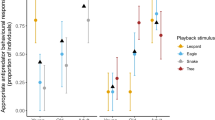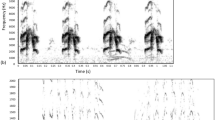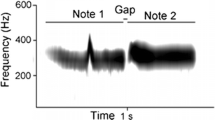Abstract
Most birds rely on imprinting and experience with conspecifics to learn species-specific recognition cues. Australian brush-turkeys (Alectura lathami) do not imprint and form no bonds with parents. They hatch asynchronously, disperse widely and meet juvenile conspecifics at an unpredictable age. Nevertheless, in captivity, hatchlings respond to other chicks. A recent study, which involved the use of robotic models, found that chicks prefer to approach robots that emit specific visual cues. Here, we evaluated their response to acoustic cues, which usually play an important role in avian social cognition. However, in simultaneous choice tests, neither 2-day-old nor 9-day-old chicks preferred the choice arm with playback of either chick or adult conspecific calls over the arm containing a silent loudspeaker. Chicks of both age classes, however, scanned their surroundings more during chick playback, and the response was thus consistent in younger and older chicks. We also presented the chicks with robotic models, either with or without playback of chick calls. They did not approach the calling robot more than they did the silent robot, indicating that the combination of visual and acoustic cues does not evoke a stronger response. These results will allow further comparison with species that face similar cognitive demands in the wild, such as brood parasites. Such a comparative approach, which is the focus of cognitive ecology, will enable us to further analyse the evolution and adaptive value of species recognition abilities.




Similar content being viewed by others
References
Beecher MD, Stoddard PK, Loesche P (1985) Recognition of parents' voices by young cliff swallows. Auk 102:600–605
Beer CG (1969) Laughing Gull chicks: recognition of their parents' voices. Science 166:1030–1032
Buitron D, Nuechterlein GL (1993) Parent–young vocal communication in eared grebes. Behaviour 127:1–20
Burger J, Gochfeld M, Boarman WI (1988) Experimental evidence for sibling recognition in common terns (Sterna hirundo). Auk 105:142–148
Davies NB (2000) Cuckoos, cowbirds and other cheats. T. & A.D. Poyser Ltd., London
Evans RM (1973) Differential responsiveness of young Ring-billed Gulls and Herring Gulls to adult vocalisations of their own and other species. Can J Zool 51:759–770
Falls JB (1982) Individual recognition by sound in birds. In: Kroodsma DE, Miller EH, Ouellet H (eds) Acoustic communication in birds. Academic Press, New York, pp 237–278
Freeberg TM (1999) Spatial associations provide a context for social learning of courtship patterns in brown-headed cowbirds (Molothrus ater). J Comp Psych 113:327–332
Freeberg TM, King AP, West MJ (1995) Social malleability in cowbirds (Molothrus ater artemisiae)—species and mate recognition in the first 2 years of life. J Comp Psych 109:357–367
Göth A (2001) Innate predator recognition in Australian brush-turkey (Alectura lathami, Megapodiidae) hatchlings. Behaviour 138:117–136
Göth A (2002) Behaviour of Australian Brush-turkey (Alectura lathami, Galliformes: Megapodiidae) chicks following underground hatching. J Ornith 143:477–488
Göth A, Evans CS (2004) Social responses without early experience: Australian brush-turkey chicks use specific visual cues to aggregate with conspecifics. J Exp Biol 207:2199–2208
Göth A, Jones DN (2003) Ontogeny of social behaviour in the megapode Australian brush-turkey (Alectura lathami). J Comp Psych 117:36–43
Göth A, Proctor H (2002) Pecking preferences in hatchlings of the Australian brush-turkey, Alectura lathami (Megapodiidae): the role of food type and colour. Austr J Zool 50:93–102
Göth A, Vogel U (2002) Social behaviour of two free-ranging chicks of Australian brush-turkey Alectura lathami. Corella 26:1–3
Göth A, Vogel U (2003) Juvenile dispersal and habitat selectivity in the megapode Alectura lathami (Australian brush-turkey). Wildlife Res 30:69–74
Gottlieb G (1981) Roles of early experience in species-specific perceptual development. In: Aslin RN, Alberts JR, Petersen MR (eds) Development of perception: psychobiological perspectives. Academic Press, New York, pp 5–44
Halpin ZT (1991) Kin recognition cues of vertebrates. In: Hepper PG (ed) Kin recognition. Cambridge University Press, Cambridge, pp 220–258
Hauber ME, Sherman PM, Paprika D (2000) Self-referent phenotype matching in a brood parasite: the armpit effect in brown-headed cowbirds (Molothrus ater). Anim Cogn 3:113–117
Hauber ME, Sherman PM (2001) Self-referent phenotype matching: theoretical considerations and empirical evidence. Trends Neurosc 24:609–616
Hauber ME, Russo SE, Sherman PM (2001) A password for species recognition in a brood-parasitic bird. Proc Roy Soc Lond Ser B 268:1041–1048
Holmes WG, Sherman PM (1982) The ontogeny of kin recognition in two species of ground squirrels. Am Zool 22:491–517
Jones DN (1988) Construction and maintenance of the incubation mounds of the Australian brush-turkey Alectura lathami. Emu 88:210–218
Jones DN (1990) Social organization and sexual interactions in Australian brush-turkeys (Alectura lathami): implications of promiscuity in a mound-building megapode. Ethology 84:89–104
Jones DN, Dekker RW, Roselaar CS (1995) The megapodes. Oxford University Press, Oxford
King AP, Freeberg TM, West MJ (1996) Social experience affects the process and outcome of vocal ontogeny in two populations of cowbirds (Molothrus ater). J Comp Psych 110:276–285
King AP, West MJ (1977) Species identification in the North American cowbird: appropriate responses to abnormal song. Science 195:1002–1004
Lefevre K, Montgomery R, Gaston AJ (1998) Parent–offspring recognition in thick-billed murres (Aves: Alcidae). Anim Behav 55:925–938
Leonard ML, Horn AG, Brown CR, Fernandez NJ (1997) Parent–offspring recognition in tree swallows, Tachycineta bicolor. Anim Behav 54:1107–1116
Marler P (1997) Three models of song learning: evidence from behaviour. J Neurobiol 33:501–516
Palestis BG, Burger J (1999) Individual sibling recognition in experimental broods of common tern chicks. Anim Behav 58:375–381
Proffitt FM, McLean IG (1991) Recognition of parents calls by chicks of the Snares Crested Penguin. Bird Behav 9:103–113
Searby A, Jouventin P, Aubin T (2004) Acoustic recognition in macaroni penguins: an original signature system. Anim Behav 67:615–625
Shapiro LJ (1980) Species identification in birds: a review and synthesis. In: Roy A (ed) Species identity and attachment. Garland STPM Press, New York, pp 69–111
Sherman PW (1991) Multiple mating and kin recognition by self-inspection. Ethol Sociobiol 12:377–386
Shettleworth SJ (1998) Cognition, evolution, and behavior. Oxford University Press, New York
Skutch AF (1976) Parent birds and their young. University Texas Press, Austin, Texas
Wanker R, Apcin J, Jennerjahn B, Waibel B (1998) Discrimination of different social companions in spectacled parrotlets (Forpus conspicillatus): evidence for individual vocal recognition. Behav Ecol Sociobiol 43:197–202
Wauters AM, Richard-Yris MA (2002) Mutual influence of the maternal hen's food calling and feeding behavior on the behavior of her chicks. Dev Psychobiol 41:25–36
West MJ, King AP, White DJ (2003) The case for developmental ecology. Anim Behav 66:617–622
Whaling CS, Solis MM, Doupe AJ, Soha JA, Marler P (1997) Acoustic and neural bases for innate recognition of song. Proc Natl Acad Sci USA 94:12694–12698
Wong S (1999) Development and behaviour of hatchlings of the Australian brush-turkey Alectura lathami. Ph.D. thesis, Griffith University, Brisbane, Australia
Acknowledgements
Many thanks to the numerous volunteers from Macquarie University that assisted with egg collection, and to the landowners on the Central Coast of NSW for allowing us access to incubation mounds on their property. To C. Evans for logistical support and his help with playback exemplars, E. Larsen for building the robot chicks, R. Marshall for veterinary support, W. McTegg for chick maintenance, and to H. Berry, G. Holwell and three anonymous reviewers for their helpful comments on the manuscript. A.G. was supported by a Macquarie University Research Fellowship and grants from the Department of Psychology and Macquarie University.
Author information
Authors and Affiliations
Corresponding author
Rights and permissions
About this article
Cite this article
Barry, K.L., Göth, A. Call recognition in chicks of the Australian brush-turkey (Alectura lathami). Anim Cogn 9, 47–54 (2006). https://doi.org/10.1007/s10071-005-0003-6
Received:
Revised:
Accepted:
Published:
Issue Date:
DOI: https://doi.org/10.1007/s10071-005-0003-6




